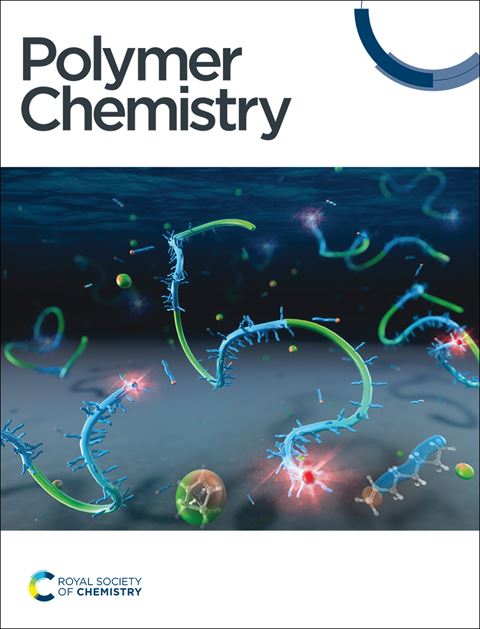Cyclic thioacetal carbonates for dual-stimuli degradable poly(vinyl ether)s with cleavable thioacetal and carbonate bonds evenly distributed in the main chains by cationic degenerative chain-transfer copolymerization
IF 4.1
2区 化学
Q2 POLYMER SCIENCE
引用次数: 0
Abstract
We report the synthesis of dual-stimuli degradable poly(vinyl ether)s with cleavable thioacetal and carbonate bonds evenly distributed in the main chains using cationic degenerative chain-transfer (DT) copolymerization of vinyl ethers with macrocyclic thioacetal carbonates (CTAC). The 22- and 26-membered cyclic thioacetal carbonates (22-CTAC and 26-CTAC) were initially synthesized by a cationic thiol-ene reaction between divinyl ether with a carbonate bond and dithiol with or without a carbonate bond under dilution conditions. These compounds were subjected to cationic copolymerization with vinyl ethers using the HCl-adduct of isobutyl vinyl ether as an initiator and ZnCl2 as a catalyst and were consumed much faster than the vinyl ethers by ring-opening reactions despite the large ring to introduce thioacetal and carbonate bonds in the main chains of the products. The in-chain thioacetal bonds subsequently served as dormant bonds for the cationic DT polymerization of vinyl ethers and enabled the synthesis of poly(vinyl ether)s with controlled total and segmental molecular weights between the thioacetal and carbonate bonds. The orthogonal degradations were successful when acid and base catalysts were used for the thioacetal and carbonate bonds, respectively; this resulted in low-molecular-weight products with controlled molecular weights. Furthermore, multiblock copolymers were synthesized by the one-time addition of the second monomer (B) to the cationic DT polymerization of the first monomer (A) and 22-CTAC and were selectively degraded into ABA and BAB triblock copolymers with acid and base catalysts, respectively.通过阳离子变性链转移共聚法生产双刺激可降解聚(乙烯基醚)的环状硫代乙醛碳酸盐,其主链中均匀分布着可裂解的硫代乙醛键和碳酸键
我们报告了利用乙烯基醚与大环硫代乙醛碳酸盐(CTAC)的阳离子变性链转移(DT)共聚合合成主链中均匀分布有可裂解硫代乙醛键和碳酸键的双刺激可降解聚(乙烯基醚)的情况。22 元和 26 元环状硫代乙醛碳酸酯(22-CTAC 和 26-CTAC)最初是由具有碳酸酯键的二乙烯基醚和具有或不具有碳酸酯键的二硫醇在稀释条件下通过阳离子硫醇-烯反应合成的。这些化合物以异丁基乙烯基醚的 HCl 加合物为引发剂,ZnCl2 为催化剂,与乙烯基醚进行阳离子共聚,尽管在产物的主链中引入了大环的硫代乙醛键和碳酸键,但在开环反应中消耗的速度比乙烯基醚快得多。链内硫代乙醛键随后成为乙烯基醚阳离子 DT 聚合反应的休眠键,并能合成硫代乙醛键和碳酸键之间总分子量和分段分子量可控的聚(乙烯基醚)。当硫代乙缩醛键和碳酸键分别使用酸催化剂和碱催化剂时,正交降解成功;从而得到了分子量可控的低分子量产品。此外,在第一单体(A)和 22-CTAC 的阳离子 DT 聚合中一次性加入第二单体(B),合成了多嵌段共聚物,并在酸催化剂和碱催化剂的作用下分别选择性地降解为 ABA 和 BAB 三嵌段共聚物。
本文章由计算机程序翻译,如有差异,请以英文原文为准。
求助全文
约1分钟内获得全文
求助全文
来源期刊

Polymer Chemistry
POLYMER SCIENCE-
CiteScore
8.60
自引率
8.70%
发文量
535
审稿时长
1.7 months
期刊介绍:
Polymer Chemistry welcomes submissions in all areas of polymer science that have a strong focus on macromolecular chemistry. Manuscripts may cover a broad range of fields, yet no direct application focus is required.
 求助内容:
求助内容: 应助结果提醒方式:
应助结果提醒方式:


